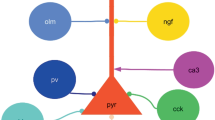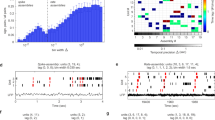Abstract
There are two prominent features for place cells in rat hippocampus. The firing rate remarkably increases when rat enters the cell’s place field and reaches a maximum around the center of place field, and it decreases when the animal approaches the end of the place field. Simultaneously the spikes gradually and monotonically advance to earlier phase relative to hippocampal theta rhythm as the rat traverses along the cell’s place field, known as temporal coding. In this paper, we investigate whether two main characteristics of place cell firing are independent or not by mainly focusing on the generation mechanism of the unimodal tuning of firing rate by using a reduced CA1 two-compartment neuron model. Based on recent evidences, we hypothesize that the coupling of dendritic with the somatic compartment is not constant but dynamically regulated as the animal moves further along the place field, in contrast to previous two-compartment modeling. Simulations show that the regulable coupling is critically responsible for the generation of unimodal firing rate profile in place cells, independent of phase precession. Predictions of our model accord well with recent observations like occurrence of phase precession with very low as well as high firing rate (Huxter et al. Nature 425:828–832, 2003) and persistency of phase precession after transient silence of hippocampus activity (Zugaro et al. Nat Neurosci 8:67–71, 2005.
Similar content being viewed by others
References
Adem A, Jolkkonen M, Bogdanovic N, Islam A, Karlsson E (1997) Localization of M1 muscarinic receptors in rat brain using selective muscarinic toxin-1. Brain Res Bull 44: 597–601
Artemenko DP (1972) Role of hippocampal neurons in theta-wave generation. Neurophysiologia 4: 409–415
Booth V, Bose A (2001) Neural mechanisms for generating rate and temporal codes in model CA3 pyramidal cells. J Neurophysiol 85: 2432–2445
Booze RM, Crisostomo EA, Davis JN (1993) Beta-adrenergic receptors in the hippocampal and retrohippocampal regions of rats and guinea pigs: autoradiographic and immunohistochemical studies. Synapse 13: 206–214
Bose A, Booth V, Recce M (2000) A temporal mechanism for generating the phase precession of hippocampal place cells. J Comput Neurosci 9: 5–30
Bose A, Recce M (2001) Phase precession and phase-locking of hippocampal pyramidal cells. Hippocampus 11: 204–215
Burgess N, Jackson A, Hartley T, O’Keefe J (2000) Predictions derived from modelling the hippocampal role in navigation. Biol Cybern 83: 301–312
Burgess N, Barry C, O’Keefe J (2007) An oscillatory interference model of grid cell firing. Hippocampus 17: 801–812
Buzsáki G (2002) Theta oscillations in the hippocampus. Neuron 33: 325–340
Ekstrom AD, Meltzer J, McNaughton BL, Barnes CA (2001) NMDA receptor antagonism blocks experience-dependent expansion of hippocampal “place fields”. Neuron 31: 631–638
Fox SE (1989) Membrane potential and impedance changes in hippocampal pyramidal cells during theta rhythm. Exp Brain Res 77: 283–294
Gasparini G, Migliore M, Magee JC (2004) On the initiation and propagation of dendritic spikes in CA1 pyramidal neurons. J Neurosci 24: 11046–11056
Golding NL, Spruston N (1998) Dendritic sodium spikes are variable triggers of axonal action potentials in hippocampal CA1 pyramidal neurons. Neuron 21: 1189–1200
Golding NL, Kath W, Spruston N (2001) Dichotomy of action-potential backpropagation in CA1 pyramidal neuron dendrites. J Neurophysiol 86: 2998–3010
Hafting T, Fyhn M, Bonnevie T, Moser M, Moser E (2008) Hippocampus-independent phase precession in entorhinal grid cells. Nature 453: 1248–1253
Harris KD, Henze DA, Hirase H, Leinekugel X, Dragoi G, Czurkó A, Buzsáki G (2002) Spike train dynamics predicts theta-related phase precession in hippocampal pyramidal cells. Nature 417: 738–741
Hartley T, Burgess N, Lever C, Cacucci F, O’Keefe J (2000) Modeling place fields in terms of the cortical inputs to the hippocampus. Hippocampus 10: 369–379
Harvey CD, Collman F, Dombeck DA, Tank DW (2009) Intracellular dynamics of hippocampal place cells during virtual navigation. Nature 461: 941–946
Hoffman DA, Johnston D (1999) Neuromodulation of dendritic action potentials. J Neurophysiol 81: 408–411
Hoffman DA, Magee JC, Colbert CM, Johnston D (1997) K + channel regulation of signal propagation in dendrites of hippocampal pyramidal neurons. Nature 387: 869–875
Hu H, Vervaeke K, Graham L, Storm JF (2009) Complementary theta resonance filtering by two spatially segregated mechanisms in CA1 hippocampal pyramidal neurons. J Neurosci 29: 14472–14483
Huhn Z, Orbán G, Érdi P, Lengyel M (2005) Theta oscillation-coupled dendritic spiking integrates inputs on a long time scale. Hippocampus 15: 950–962
Huxter J, Burgess N, O’Keefe J (2003) Independent rate and temporal coding in hippocampal pyramidal cells. Nature 425: 828–832
Jarsky T, Roxin A, Kath WL, Spruston N (2005) Conditional dendritic spike propagation following distal synaptic activation of hippocampal CA1 pyramidal neurons. Nat Neurosci 8: 1667– 1676
Johnston D, Hoffman DA, Colbert CM, Magee JC (1999) Regulation of back-propagating action potentials in hippocampal neurons. Curr Opin Neurobiol 9: 288–292
Kamondi A, Acsády L, Wang X-J, Buzsáki G (1998) Theta oscillations in somata and dendrites of hippocampal pyramidal cells in vivo: activity-dependent phase-precession of action potentials. Hippocampus 8: 244–261
Kepecs A, Wang X-J (2000) Analysis of complex bursting in cortical pyramidal neuron models. Neurocomputing 32–33: 181–187
Kepecs A, Wang X-J, Lisman J (2002) Bursting neurons signal input slope. J Neurosci 22: 9053–9062
Larkum ME, Zhu JJ, Sakmann B (2001) Dendritic mechanisms underlying the coupling of the dendritic with the axonal action potential initiation zone of adult rat layer 5 pyramidal neurons. J Physiol 533: 447–466
Lengyel M, Szatmáry Z, Érdi P (2003) Dynamically detuned oscillations account for the coupled rate and temporal code of place cell firing. Hippocampus 13: 700–714
Leung LS, Yim CY (1986) Intracellular records of theta rhythm in hippocampal CA1 cells of the rat. Brain Res 367: 323–327
Lever C, Burton S, Jeewajee A, O’Keefe J, Burgess N (2009) Boundary vector cells in the subiculum of the hippocampal formation. J Neurosci 29: 9771–9777
Magee JC (1998) Dendritic hyperpolarization-activated currents modify the integrative properties of hippocampal CA1 pyramidal neurons. J Neurosci 18: 7613–7624
Magee JC (2001) Dendritic mechanisms of phase precession in hippocampal CA1 pyramidal neurons. J Neurophysiol 86: 528–532
Mainen Z, Sejnowski TJ (1996) Influence of dendritic structure on firing pattern in model neocortical neurons. Nature 382: 363–366
McNaughton BL, Barnes CA, O’Keefe J (1983) The contributions of position, direction, and velocity to single unit activity in the hippocampus of freely moving rats. Exp Brain Res 52: 41–49
Mehta MR, Quirk MC, Wilson MA (2000) Experience-dependent asymmetric shape of hippocampal receptive fields. Neuron 25: 707–715
Mehta MR, Lee AK, Wilson MA (2002) Role of experience and oscillations in transforming a rate code into a temporal code. Nature 417: 741–746
Migliore M, Ferrante M, Ascoli GA (2005) Signal propagation in oblique dendrites of CA1 pyramidal cells. J Neurophysiol 94: 4145–4155
O’Keefe J, Recce ML (1993) Phase relationship between hippocampal place units and the EEG theta rhythm. Hippocampus 3: 317–330
O’Keefe J, Burgess N (2005) Dual phase and rate coding in hippocampal place cells: theoretical significance and relationship to entorhinal grid cells. Hippocampus 15: 853–866
Pan E, Colbert CM (2001) Subthreshold inactivation of Na + and A-type K + channels supports the activity-dependent enhancement of back-propagating action potentials in hippocampal CA1 pyramidal neurons. J Neurophysiol 85: 1013–1016
Pinsky PF, Rinzel J (1994) Intrinsic and network rhythmogenesis in a reduced traub model for CA3 neurons. J Comput Neurosci 1: 39–60
Quirk MC, Blum KI, Wilson MA (2001) Experience-dependent changes in extracellular spike amplitude may reflect regulation of dendritic action potential back-propagation in rat hippocampal pyramidal cells. J Neurosci 21: 240–248
Skaggs WE, McNaughton BL, Wilson MA, Barnes CA (1996) Theta phase precession in hippocampal neuronal populations and the compression of temporal sequences. Hippocampus 6: 149–172
Solstad T, Boccara CN, Kropff E, Moser MB, Moser EI (2008) Representation of geometric borders in the entorhinal cortex. Science 322: 1865–1868
Spencer WA, Kandel ER (1961) Electrophysiology of hippocampal neurons. J Neurophysiol 24: 272–288
Spruston N (2008) Pyramidal neurons: dendritic structure and synaptic integration. Nat Rev Neurosci 9: 206–221
Yamaguchi Y (2003) A theory of hippocampal memory based on theta phase precession. Biol Cybern 89: 1–9
Yamaguchi Y, Aota Y, McNaughton BL, Lipa P (2002) Bimodality of theta phase precession in hippocampal place cells in freely running rats. J Neurophysiol 87: 2629–2642
Yamaguchi Y, Sato N, Wagatsuma H, Wu Z, Molter C, Aota Y (2007) A unified view of theta-phase coding in the entorhinal-hippocampal system. Curr Opin Neurobiol 17: 197–204
Ylinen A, Soltész I, Bragin A, Penttonen M, Sik A, Buzsáki G (1995) Intracellular correlates of hippocampal theta rhythm in identified pyramidal cells, granule cells and basket cells. Hippocampus 5: 78–90
Yuste R, Gutnick MJ, Saar D, Delaney KR, Tank DW (1994) Ca 2+ accumulations in dendrites of neocortical pyramidal neurons: an apical band and evidence for two functional compartments. Neuron 13: 23–43
Zugaro M, Monconduit L, Buzsáki G (2005) Spike phase precession persists after transient intrahippocampal perturbation. Nat Neurosci 8: 67–71
Author information
Authors and Affiliations
Corresponding author
Rights and permissions
About this article
Cite this article
Wu, Z., Yamaguchi, Y. Independence of the unimodal tuning of firing rate from theta phase precession in hippocampal place cells. Biol Cybern 102, 95–107 (2010). https://doi.org/10.1007/s00422-009-0359-9
Received:
Accepted:
Published:
Issue Date:
DOI: https://doi.org/10.1007/s00422-009-0359-9




